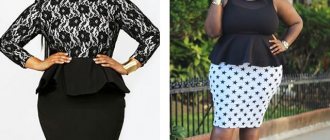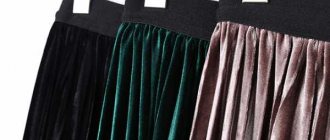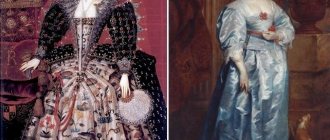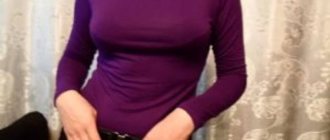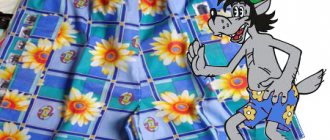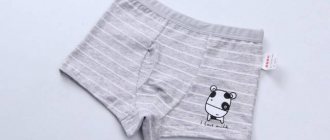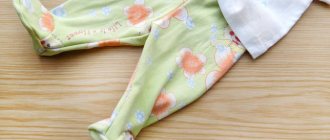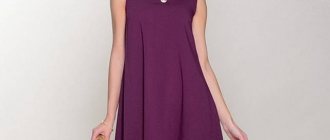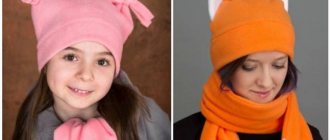Master class, Dresses, Knitwear
Hello, friends!
It is especially difficult for a novice tailor to sew things with complex processing or a complex cut. Beginners are surprised: How can you sew a dress in a couple of hours, especially a knitted one?
What to do when sewing is difficult and scary?
Should you give up sewing or choose to sew things according to your capabilities, improving your sewing skills over and over again?
The second option is smarter and will definitely lead to the fulfillment of your dream - learning to sew.
Today I propose to consider sewing a dress from knitted fabric, which even a beginner can sew in a few hours.
Moreover, the simple cut and simple technological processing do not detract from the effectiveness and comfort of the dress. With a little time and material, you can shine in a new outfit while walking the streets or at parties.
To sew a dress you will need:
- A piece of knitted fabric, 150 cm wide;
- Threads matching the tone;
- Elastic band 1 cm wide;
- Scissors;
- Pins;
- Chalk or self-disappearing marker;
- Sewing machine;
- Overlock (optional);
- Iron.
Model selection
The purpose of the dress changes depending on the choice of material - thick knitwear in everyday colors or thin, bright and shining material - it's up to you.
In my case, the dress is casual.
Seam at the waist with a flowing half-sun skirt. Bodice with one-piece sleeves. The neckline is oval. The bottom of the sleeve is finished with a cuff. The bottom of the skirt is a hem seam with an open cut. The neckline is finished with facing.
Dress sketch
Material selection
Knitted fabric is quite thin, easily draped, and stretches in one or two directions.
Material consumption
With a fabric width of 150 cm or more, you need: 1 bodice length + 1 skirt length + seam allowances of 5-7 cm. If the hip measurement does not fit the width of the fabric, take 2 skirt lengths.
I recommend drawing a miniature/scale drawing of the pattern, making a test layout and checking the amount of material.
This dress looks great with a long skirt. When choosing a model and calculating the amount of fabric, take into account the change in skirt length.
Preparing for cutting
I decate the knitted fabric, fold it, aligning the cuts, and chop along the edges to avoid curling of the knitwear.
Read this article about how and why you need to decate knitwear.
Lots of books on sewing - CLICK
Tools for sewing knitwear
There is no need for special equipment for working with knitwear. It is important to have on hand:
Sewing machine. It should be supplied with:
- Needles with a rounded head. There are several varieties: “jersey” or “stretch”. The first variety is sewing knitwear with a mixture of wool and cotton. The second is a synthetic fiber with a large percentage of lycra.
Elegant knitted dress
Regarding the size of the required needle, no one can give a comprehensive answer. One thing is clear: the thinner the fabric, the smaller the needle should be for sewing a fabric product.
Note! Before you start sewing, it would be a good idea to sew a stitch on the rags and check the quality of the sewing.
- Double needle - removable mechanism. Feature: makes several stitches at the same time. Suitable for piping the bottom of the product, armholes. The front side will have parallel stitches and the back side will have zigzag stitches.
Double needle - removable mechanism
Important! The double needle is suitable for any type of sewing machine.
Threading a double needle is done from two spools at the same time. Reels are installed on both pins of the machine so that they can be unwinded in different directions. This will eliminate the possibility of thread tangling. If the machine has one pin, then the second spool is placed in a box and the thread is wound.
The finishing touches of the look
Pumps and a clutch on a chain can complement the outfit. These elements fit into almost any bow. The finishing touches to the business lady's image will be a bag with a rigid base and short handles, a gauze scarf, and a contrasting belt. It is important that the accessories are in harmony with each other in color and design.
Underwear
If the dress fits loosely, then there are no difficulties with choosing underwear. For tight-fitting knitwear, there are products with a smooth texture, preferably flesh-colored, so that the underwear does not show through. When you need to adjust your figure, modeling underwear is suitable - with stretch and good support.
Secrets
If the lower thread does not catch, follow these steps:
- Loosen the needle fastening screw;
- Lower the needles a little lower, but don’t do it too much;
- Clamp the fastening screw;
- Check to see if the defect has been fixed.
Upper conveyor - several layers of stretch fabric are sewn together. This mechanism allows the top layer of fabric to scroll, while the bottom conveyor feeds the bottom panel. The main task of conveyors is to ensure the synchronous movement of two sheets of material.
Sewing on a machine
The mechanism will not be needed if you have a professionally developed habit of manually basting 2 panels of fabric together. This mechanism is necessary for industrial sewing of products; its use significantly saves workers’ time.
The walking foot pushes through the top layer of fabric. For beginner seamstresses, it is better to baste 2 pieces of fabric by hand to begin with.
Note! Threads are selected smooth, elastic with long fiber: polyester, nylon. Most beginning seamstresses do not go into such details as the composition of the thread - they choose from those that are available. The main rule is to match the color scheme of the product.
Material selection
When choosing material for a dress, you need to adhere to the following criteria:
- Decide on a style. With a complex cut of clothing, the material should be thin. If there is drapery, preference should be given to the appropriate type of knitwear;
- Take into account your complexion when choosing material for a dress;
- Surface of matter: glossy or matte. The gloss is suitable for women with ideal figure proportions. A plump woman needs to carefully consider the choice of fabric and style.
- Seasonality of the product. Summer knitwear and winter knitwear will differ in their properties and thickness parameters.
Note! The choice of a specific type of knitted fabric depends on the style of the dress, body shape and wishes.
You might be interested in Sewing fabric hair ties yourself
If knitwear mixed with synthetics stretches, it is not necessary to carry out preparatory work. The pattern of the knitted dress is laid out and the product is cut out.
Cotton knitwear (“linen”) shrinks after several washes. This must be taken into account when cutting the material. You need to wash the material several times and dry it. The material will shrink and after that you can iron the product and cut it. From this fabric you can make a children's suit for a girl, a home set, or a long sundress. This product can be sewn by a novice seamstress.
Ready product
Ironing rule:
- The fabric is ironed from the wrong side, using an iron. Knitwear shines when ironed and does not emit odor. You need to be careful not to smooth out the wrinkle - the tuck will be difficult to remove, it remains for a long time. You can level the material with your palm;
- Avoid stretching the fiber - waves and bubbles will appear on the fabric, which does not look very good on the finished product and interferes with sewing;
- There is no need to move the iron over the fabric. Knitwear is ironed carefully; you just need to press the iron onto the fabric, hold it, release it, and press it again in another place. This movement will be more gentle on the knitted fabric.
- Iron knitwear only when dry. The material may warp, the fabric will stretch to size. This happens when a dry jersey T-shirt is ironed.
Cell, abstraction or bomb red?
Daring fashionistas and everyone who likes to experiment with prints are in luck!
After all, this year both solid colors and various patterns are relevant.
Classic is always a good solution
Classic, basic colors - white, dark, gray and beige - still fit easily into any wardrobe.
Stylists note that even within the framework of universal tones, you can choose some shades that suit more.
The white palette contains ivory and vanilla - they have been exciting the minds of bloggers for several years now.
Why not incorporate them into your wardrobe?
Create a bright mood
The Pantone Institute presented a whole palette of trendy tones. At the top of the fashion Olympus are bright red, blue, yellow.
But there was also a place for pastel shades: if you want tenderness, it is better to choose peach, pink, reminiscent of bubble gum.
The stripe is the head of everything
The geometry is still relevant, but not every stripe looks modern. Now at the height of fashion are wide lines that can be located both horizontally and vertically (and even diagonally).
If a lady is not afraid of experiments, then why not choose contrasting colors?
And for modest girls, a less saturated ornament is suitable, which visually looks like a single whole.
Polka dots are not losing ground
Feminine polka dots have been loved by designers since the 20s of the last century. But if back then girls only wore large patterns, now there are many options.
Both large polka dots and small dots are trending.
Abstraction in the style of Van Gogh
The designs draw attention to both the dress and its owner. The simplest option is with flowers. It is better to give preference to light, watercolor-like images.
But if your courage and creativity are off the scale, then you can wear an outfit with a pop art pattern. Or - fragments of famous paintings.
Material consumption
The calculation of the material depends on the complexity of the style of the knitted dress pattern, the parameters of the width of the material, and the pattern.
| Style | Quantity of material R.40-46 | Quantity of material R. 50-56 |
| Straight with sleeve | Product length, sleeves + 40 cm | 2 product lengths + 40 cm |
| With sleeves and flared skirt | 2 product lengths, sleeves + 40 cm | Similar to r.40-46 |
| Sundress straight | Product length+ 40 cm | Similar to r.40-46 |
| Flared sundress | 2 product lengths + 40 cm | Similar to R. 40-46 |
Dress pattern
What to wear every day?
Most women, even in everyday life, do not hide their love for knitwear outfits. And designers, knowing this, never tire of offering new interpretations of simple everyday dresses.
In 2021, sports style is in fashion. It is distinguished by its convenience, the presence of pockets, and bright colors. Such products are easy to combine within casual or street style. To create a stunning look, you will need women's Converse and a bomber jacket that are trendy this season.
Another unusual choice is noodles. Thin knitwear seductively hugs the figure. The fabric provides good air exchange, so the noodles will be comfortable even in the hottest summer.
To “contain” the sexy style a little, you can complement it with simple oversized jackets, denim jeans or straight cardigans.
Features and techniques of sewing knitwear
When working with the sequence of making knitwear patterns, the features of the fabrics used for cutting and sewing are taken into account:
- Cut fabrics. Cut like fabric;
- Semi-regular canvases - processing is not carried out on all sides;
- Regular - the parts are knitted in the round, you just need to sew them together.
Cut fabrics
Sewing technique:
- The direction of the grain thread is parallel to the straight edge of the product;
- When cutting, the lower cuts of the lobes are directed in one direction;
- To prevent skew, the material is not stretched across;
- If it is difficult to mark the lines when cutting, you can carefully connect the fabric parts with needles, observing the same seam allowances;
- You should monitor the stretchability and strength of the seam. The seam should not pull or “collect” the material. The product should stretch along with the seam;
- For parts, a shallow cut of the fabric in the allowance area is allowed;
- The edging of the armholes and neckline is done with an oblique strip of fabric;
- The cover stitch is used when processing the neckline;
- If you don't want the seam to stretch, you need to add bias tape when stitching it;
- The turtleneck collar is sewn on, stretching the fabric slightly;
- The bottom is folded by hand using a loose seam. The upper edge of the folded fabric turns inward at a distance of half a centimeter;
- The seams are ironed through gauze during work.
We break all the canons
Just a couple of years ago, stylists unanimously repeated: it’s better for crumpets to forget about knitwear forever! Today, fashion rules are not so strict. You need to avoid loose fabrics, while tight knitting will only beautify any woman.
But how to hide a full belly or thighs?
It is enough to choose suitable styles and colors.
Here are ideas that all plus-size fashionistas should take note of:
- the smell at the waist corrects the figure and makes the silhouette more feminine;
- the high belt line and the emphasis on it visually lengthens the height;
- the presence of vertical lines - within the print or cut.
Always wear a dress that fits. Shapeless robes are a thing of the past, but tight-fitting clothes when clothes are simply too small are also not flattering. A particularly appetizing figure.
Don't have the right size?
It’s worth thinking about how to sew the desired model.
Pattern for a dress with a stand-up collar
There are several types of stand-up collars:
- Shirt (turn-down with cutting stand). Used for sewing women's blouses and men's shirts. Comfortable to wear, gently fits the neck.
Important. The width and parameters of the stand depend on the configuration of the collar, determined by the model and the designer.
You might be interested in: Creating soutache jewelry with your own hands for beginners
- Turn-down with a one-piece stand;
- Tuxedo Collar;
Pattern for a dress with a stand-up collar
- Mandarin collar. The collar fits snugly to the neck without fastening. In some products, a fastener is provided and is a loop of fabric that is placed over a button with a stem.
To create a pattern, use the pattern of the shelf and the back of the product.
The length of the neckline of the front and back from the pattern is measured (the distance between the control points for sewing in the collar).
A rectangle ABCD is constructed with a length of half the length of the neckline on the pattern, a height of 6.5 cm. 4 cm are laid upward from the point (the width of the collar varies depending on the chosen model). From point D, 3 cm is laid upward. A curved line is drawn for sewing in the collar. The short side of the collar is drawn at a right angle to the piece, the upper side along the pattern or manually.
Cut out several parts along the fold line at the center of the back. Seam allowances are 1.5 cm. The outer part of the collar is duplicated with interlining fabric.
Choose your favorite style of straight dress. Download the pattern and check the correctness of its construction with a measuring tape.
Note! The pattern does not include allowances; fabric is purchased taking into account 4 cm allowances on the sides for hems.
Determining the percentage of fabric stretchability
Since knitwear is a stretchy fabric, to work with it you need to know its stretch percentage.
To find out how much stretch knitwear has, you need to do the following:
- Measure a piece of fabric 10 cm wide in a relaxed state.
- Stretch this piece of fabric as much as you want the dress to hug your body.
- Subtract the size of the fabric in the relaxed state from the size of the fabric in the stretched state.
The difference is the stretchability of the fabric; all that remains is to convert it into percentages. For example, if after the above steps you get 6 cm, then the percentage of fabric stretching is 60%, if 1.5 - then 15%, if 3 cm - then 30%, etc.
Dress pattern with drapery at the waist
The product is based on the pattern of a fitted dress, which is slightly modified using ray lines.
Dress pattern with drapery at the waist
- Cut out the pattern, rays, without cutting 0.5 cm to the edge. Extend the workpiece.
- The darts on the yoke are closed, it is connected to the right side, and the front of the dress is connected to the left.
- The pattern is transferred to the fabric.
- The back of the product is cut along the fold.
- The seam is sewn, which was marked on the pattern in red.
- The stitched part is folded in half, the stitching begins from the fold line of the fabric at a distance of 4 cm to form a hole into which the part of the upper part is threaded.
- It turns out to be assembled in a corner. Afterwards, knots are tied and at the very beginning of the overlock stitch, a fastening is made.
- The upper part is threaded into the hole that was left.
- Fastenings are being made.
- The other 2 seams are sewn together in the same way.
- The middle part of the back is sewn.
- The product is sewn from the sides and along the shoulder seams. Processing the bottom of the dress with a hidden seam, manually.
- The neckline and armholes are processed similarly.
Note! A dress with draping on the belly is perfect for those who have ideal body measurements. Drapery on the bodice will emphasize the dignity of the chest and hide wide hips.
We won't show anything unnecessary
2021 is simply a paradise for fashion lovers. After all, this year the trend is a variety of lengths.
The right length can also help shape your figure.
Opening the legs
Options that end above the knee are traditionally the choice of young people. However, stylists and bloggers suggest wearing such products to middle-aged ladies.
What's the secret? How to look appropriate?
Here are a couple of tips:
- The tight cut is best left for another fabric.
- To prevent the model from looking vulgar, it should be modest - without wide cuts or slits.
- The right combination makes all the difference—flat soles create a completely casual look.
We emphasize elegance
Options that slightly cover the knee always look especially feminine. In the new autumn-winter season, midi is generally the most fashionable length, which successfully emphasizes the beauty of any legs.
Those girls who already have medium-length clothes are lucky. After all, you can combine them with shoes without heels (for example, with sneakers that are fashionable this year) and with stiletto heels.
In addition, there is another trend that can only be met with clothes of the required length. This year, skirts should cover the tops of boots or ankle boots.
Showcasing femininity
Softly falling models made of dense material to the floor are a godsend for cold weather. Plus, it’s easy to look beautiful in this outfit.
Several styles are popular in the New Year:
- A straight, slightly loose robe, which is belted with a wide belt.
- A form-fitting model that accentuates smooth curves.
Bloggers and fashion designers recommend combining trendy products with flat ankle boots, light autumn boots and an oversize coat.
Video for you:
Pattern of a sports dress made of jersey with a hood.
You will need to cut out the details:
- Shelf - a part with a bend;
- Back - 2 pcs.;
- Sleeve - 2 (if there is a seam - 4);
- Hood - 2;
- Hood facing -2;
- Sleeve cuff - 2;
- Bottom cuff - 1.
When working with a pattern, you should always follow the instructions.
Pattern of a sports dress made of jersey with a hood
Step-by-step algorithm
- Taking measurements: chest, arm, waist, hips. Arm length and product length.
Important! Before cutting, the fabric must be steamed. The material may shrink - this must be taken into account. When laying out patterns, the direction of the grain thread is taken into account.
- Selecting a pattern. Select any product you like, download and print the pattern.
- Open it up. The parts are laid out on a canvas folded in 2 layers. Paired - in the singular, parts with a fold - along the fold line. If the canvas has 1 layer, you need to remember about cutting paired parts.
- Savvy. Knitwear is basted by hand. The seams are on the fabric, do not steam them - it is better to make a running seam on the hands. After stitching the product, the basting must be removed. If the product is not basted, then the parts are chipped in the transverse direction of the seam and stitched on a machine.
- Stitching.
Important. You should monitor the tension of the thread - the thread should not be tight.
- The middle seam of the back is sewn. The allowances are ironed on both sides. The back is detached.
- The pocket is overstitched and a zigzag is made. The pocket is sewn to the shelf. All pocket allowances are pre-stitched and ironed from the inside out;
- The middle seam of the sleeve is sewn down (if the sleeve has 2 seams). The seam allowances are ironed. Sleeve stitching. The allowances are ironed, the raglan is steamed. The bottom of the sleeve is processed with a zigzag.
- The cuff is overstitched, ironed, and pinned to the edge of the sleeve. Attach the cuff to the edge. The cuff is folded over, the free edge is swept away, and attached to the previous seam.
- If you decide not to make cuffs and sleeves, fold up the sleeve sections and sew them with a double stitch.
- Shoulder seams are sewn. Iron back, steam.
- Stitching side seams. Sleeve stitching. The armhole and sleeve cap are first cut off with needles and swept away.
- Sew the hood darts. Iron to the center. Finishing the hood neckline with facing. Pin the sections of the hood to the neck. The hood is sewn in. Steamed.
- Grommets are installed.
- The hem of the bottom is stitched with a double needle.
You might be interested in this. Interesting patterns and sewing procedures for pajamas with shorts
How to cut a knitted dress with sleeves according to a pattern
There are a large number of patterns for knitwear dresses on the Internet and in fashion magazines. To sew the perfect dress, you need to know how to cut out its details correctly:
Side seam of back and front
The position of the side seams is constantly changing. This is due to the type of clothing, silhouette, human build, the presence of other seams and details, the location of darts relative to the waist, the cut of the sleeves and other factors.
Side seam of back and front
The construction comes down to determining the side lines of the depth of the dress's armhole, waist, hips and bottom and designing according to the recommendations of the pattern.
Pattern
Side seams can be located:
- Straight cut near the shoulder blade and chest;
- Loose cut and products of a different cut - closer to the middle of the armhole, aligning with it.
Find the position of the side seams using the formula: ∑B = (CrIII + Pg) - (St + Pt) - TT1.
The value (2/5÷1/4)∑B is taken into the side seam of the back and front.
Important! The position of the side seam in fitted products is determined graphically, in which the increase in looseness of the fit is 0.7 Pg. To do this, the positions of the side seam on the bust line and hips are connected by straight lines, and later by concave lines. The degree of concavity is determined by the pattern.
Shoulder line of shelf
When designing, the angle of inclination of the upper cut is important:
- Large slope - the bodice has a strict, clear shape, the delineation of the shoulder and armhole area provides freedom of movement with a gusset;
- There is little or no slope, the upper border of the sleeve is horizontal, the bodice has a large volume, a soft shape, and slack in the armhole.
Important. The width of the sleeve depends on the angle of the cut and the parameters of the armhole depth. A wide sleeve is obtained with a minimum angle of inclination.
Dress pattern with a loose fit
The basis is a dress with a semi-fitting silhouette.
- Copy the back and front of the bodice of the dress. The letters and lines involved in the construction are copied.
- Transfer the side line of the bodice to the middle of the armhole: draw a line from G4 to the intersection with the waist line.
Important! When designing a soft bodice with long sleeves, the size of the side dart opening is reduced to 1.5 cm on each side.
The back and front waist darts can have a minimum size and be replaced with tucks and gathers, according to the pattern.
In clothes with a straight, loose fit, waist darts may be absent.
Additional freedom for the sleeve is given by moving the shoulder line and back neckline.
Processing the bottom of the sleeve
Depending on the shape of the sleeve: with an elastic band or with a cuff, the processing is different.
Sleeve with elastic
The required type of sleeve should be determined and the appropriate processing done.
Unexpected but nice
What fabrics are usually chosen to make evening wear?
Surely most women are accustomed to satin, lace, and chiffon. Surprisingly, the 2021 season brought another surprise: knitted toilets are relevant even when going to the La Scala Opera or to a gala reception.
Therefore, here are a couple of interesting styles in which any girl will become a star at a party:
- asymmetry - open shoulder, uneven hem of the skirt;
- mermaid - tight-fitting to the knee, and then a sharply flaring skirt;
- new look - fitted top and very wide bottom.
The last style - new look - is a real lifesaver. After all, it looks good on any figure. The silhouette is designed in such a way as to hide full hips and highlight slender legs.
